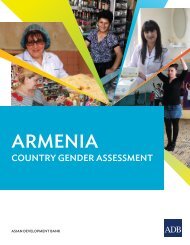Civic Activism as a Novel Component of Armenian Civil Society
English-3
English-3
Create successful ePaper yourself
Turn your PDF publications into a flip-book with our unique Google optimized e-Paper software.
However Bagiyan (2015) reports that there w<strong>as</strong> confusion among the participants regarding the<br />
capacity in which they participated. NGO member participants made contradicting statements:<br />
while one member stated that s/he participated <strong>as</strong> an individual, another member <strong>of</strong> the same<br />
NGO stated that this w<strong>as</strong> an issue that their organisation had a stake in; hence, such participation<br />
represented NGO involvement. Apart from participating in protests, NGOs had institutional<br />
involvement in the c<strong>as</strong>e: three organisations filed lawsuits against Yerevan Municipality; several<br />
cultural NGOs were involved in designing press rele<strong>as</strong>es and organising various cultural events.<br />
Interestingly, this formal participation went unnoticed by some activists, who claimed no NGO<br />
involvement in the c<strong>as</strong>e (Bagiyan 2015).<br />
5.1.5. Electric Yerevan<br />
• Background: What is the issue?<br />
The electricity supply in Armenia is exclusively provided by the Electric Networks <strong>of</strong> Armenia<br />
(ENA). Since 2006, the company h<strong>as</strong> been owned by a Russian energy holding company “Inter<br />
RAO UES”. It h<strong>as</strong> thrice incre<strong>as</strong>ed electricity prices: in 2009, 2013 and 2014. As a result, in<br />
2015, people were paying nearly twice <strong>as</strong> much for electricity <strong>as</strong> they had been paying in 2008:<br />
approximately eight US cents per kWh. According to data rele<strong>as</strong>ed by an <strong>Armenian</strong> NGO, this<br />
w<strong>as</strong> the highest price among all post-soviet republics, except Lithuania and Latvia (Epress News<br />
2015).<br />
In May 2015, ENA applied to Armenia’s Public Services Regulatory Commission to<br />
request a further incre<strong>as</strong>e in electricity prices, citing low pr<strong>of</strong>its and accumulated debts over the<br />
p<strong>as</strong>t few years. The Commission did not approve the requested incre<strong>as</strong>e <strong>of</strong> 41% (17 AMD,<br />
approximately 4 US cents), but it did approve a more modest price incre<strong>as</strong>e <strong>of</strong> 17% (7 AMD,<br />
approximately 1.5 US cents) on June 17, 2015. This incre<strong>as</strong>e is what sparked the protests, now<br />
commonly referred to <strong>as</strong> Electric Yerevan. However, that name is somewhat misleading: the<br />
protests were not confined to Yerevan but quickly spread beyond the capital.<br />
• Chronology and the main developments<br />
According to some news sources (Baitarian 2015), the first protest w<strong>as</strong> staged by a group <strong>of</strong><br />
youth activists affiliated with the ARF-D<strong>as</strong>hnaktsutyun political party. On the same day <strong>as</strong> the<br />
decision to raise prices (June 17), activists gathered in front <strong>of</strong> the Public Services Regulatory<br />
Commission’s <strong>of</strong>fice. As a result <strong>of</strong> cl<strong>as</strong>hes with the police, several activists were arrested and<br />
rele<strong>as</strong>ed hours later. This episode is not mentioned in any major subsequent news story on how<br />
the protests unfolded.<br />
On June 19, a larger crowd, describing themselves <strong>as</strong> ‘concerned citizens’ not affiliated<br />
with any political party, gathered at the Liberty Square in the centre <strong>of</strong> the city. They protested<br />
the price incre<strong>as</strong>e and announced that the government had three days to meet their demands.<br />
The three days p<strong>as</strong>sed, and the demands were not met, so the activists moved on to the<br />
next stage <strong>of</strong> the plan. On the evening <strong>of</strong> 22 June, they marched to Baghramyan Avenue: one <strong>of</strong><br />
the central streets housing the Presidential Palace, the National Assembly (the Parliament), the<br />
Constitutional Court and a number <strong>of</strong> emb<strong>as</strong>sies. News reports (Azatutyun June 23, 2015;<br />
48



